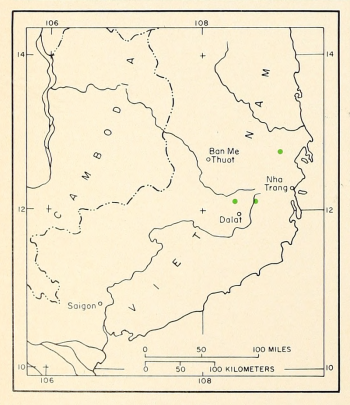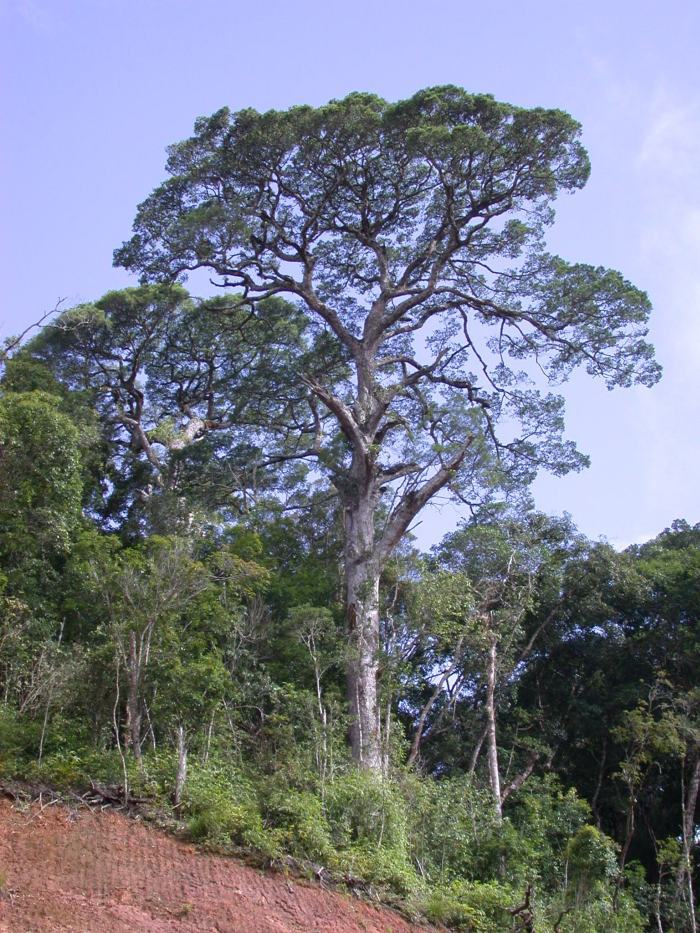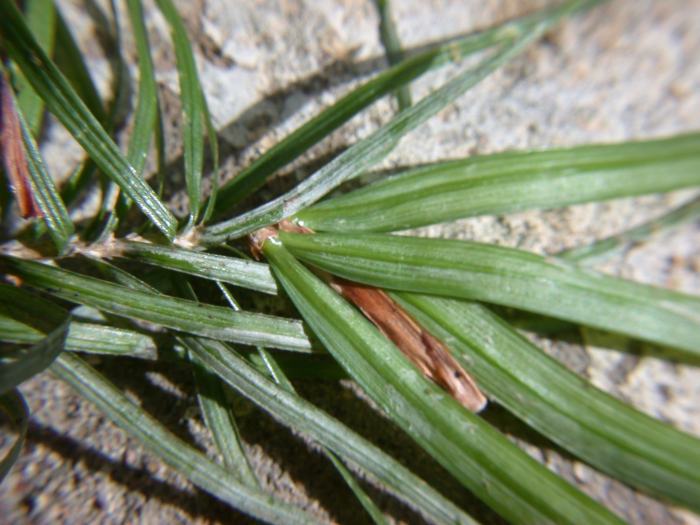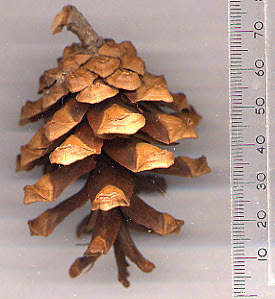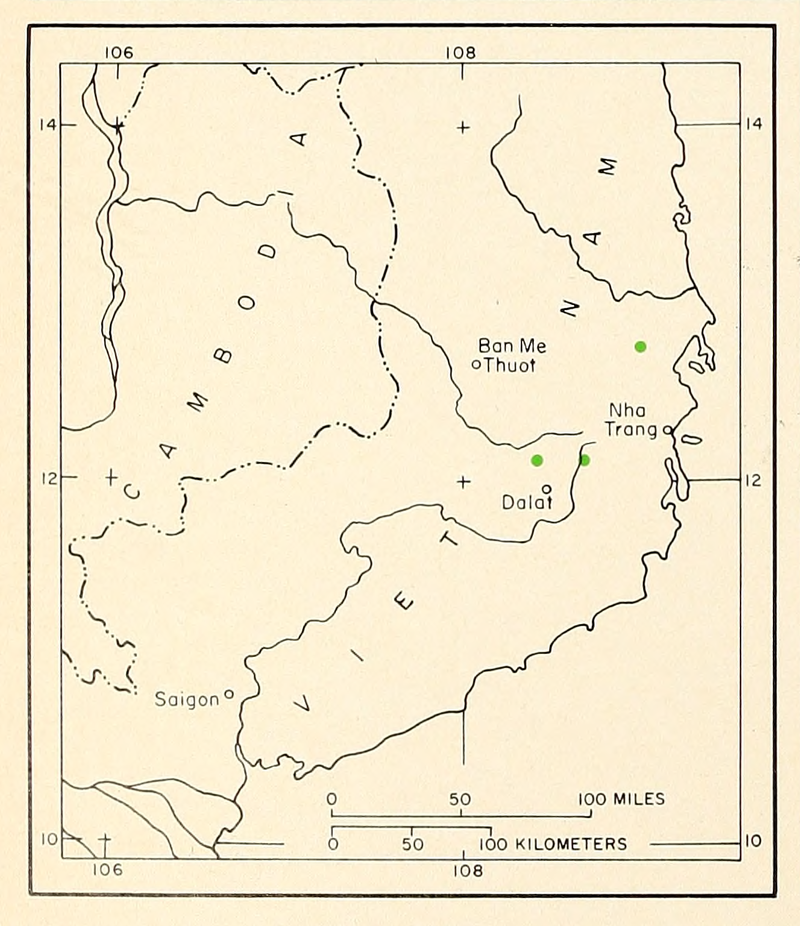subgenus Strobus (Lemmon), section Quinquefoliae (Duhamel), subsection Krempfianae (Little et Critchfield)
Pinus krempfii, as described in 1921 by Paul Henri Lecomte (1856 - 1934), in Bulletin du Muséum National d'Histoire Naturelle, 27th edition; is commonly known as Kremp's or Flat-needled pine in English, as well as Thông lá det or Ngo rà in the Vietnamese language. The species name honors German botanist M. Krempf, who collected the type specimen in 1921.
Description. Kremp's pine is an evergreen, coniferous species of tree that grows to mature heights of 120 to 180 feet (35 - 55 m); with a single, straight, often buttressed trunk up to 80 inches (200 cm) in diameter, measured at breast height; and a broad domed crown with many large branches.
- Bark is silvery gray, scaly, and flaky; peeling off into irregular fragments, having resin ducts, similar to the species of section Gerardiana.
- Leaves (needles) are lanceolate-falcate shaped, shiny dark green colored, and borne in fascicles of 2. Each needle measures 1.2 to 2.4 inches (3 - 6 cm) long by 0.08 to 0.016 inches (2 - 4 mm) wide on adult trees, much larger on juvenile trees. The fascicle sheath is composed of few broad acute scales in an alternate arrangement, with each scale markedly longer than the previous, the longest to 0.6 inch (15 mm), up to 40% of the full length of the fascicles. The foliar sheath is early deciduous; similar to that of P. bungeana, though in that species the scales are arranged in a loose spiral. Foliage is flattened on weak shoots, with fascicles flattened and held flat in a single plane, unique in Pinus. On stronger shoots foliage is all around the shoot. The shoots are glabrous, with small (0.04 inch/1 mm) decurrent scale-leaf bases deciduous by the second to fourth year. This gives the leafless shoot a strong similarity to some piñons, and most notably to P. pinceana, and later, after the scale leaf bases are shed, to P. bungeana.
- Pollen cones are sometimes carried on small, weak, pendulous, tassel-like shoots with few to no needle fascicles, a feature shared with P. pinceana. They measure 0.2 to 0.36 inch (5 - 9 mm) long and are light brown in color.
- Seed cones are ovate, comprised 12 to 20 fertile scales, colored glossy orange-brown when freshly mature, and measure 1.4 to 2.4 inches (3.5 - 6 cm). Seed scales have a well-defined dorsal umbo and no sealing band. The apophysis has a raised transverse ridge to 0.12 to 0.16 inch (3 - 4 mm) thick, and a small and unarmed umbo. Cone peduncle measures 0.28 to 0.6 inch (7 - 15 mm) long, 0.16 to 0.2 inch (4 - 5 mm) thick, curved so that cone is pendulous. Cones produced in April and May; seeds mature in July and September.
- Seeds measure 0.16 to 0.2 inch (4 - 5 mm) long with a 0.4 to 0.6 inch (10 - 15 mm) long articulate wing.
Distribution. This species is native to Vietnam - local in Khanh Hoa and Lam Dong, principally around Bi Doup mountain. The species is locally frequent, with 200 trees in one population. Grows emergent above the evergreen monsoon forest canopy on steep slopes at elevations of 4,500 to 6,000 feet (1,500 - 2,000 m) above sea level, often in mixed stands with Chamaecyparis hodginsii, Pinus dalatensis, Dacrydium elatum and other broad-leaved trees such as Symingtonia populnea and Rhodoleia championii. Pinus kesiya forest grows at relatively higher and tropical rainforest at lower elevations. It often grows in sites having black-grey, deep humus soils or humus-rich loamy soils along streams.
Hardy to USDA Zone 10 - cold hardiness limit between 30° and 40°F (-1° and +4.4°C).
